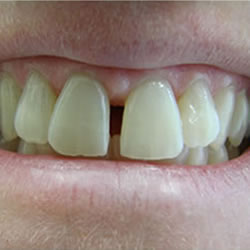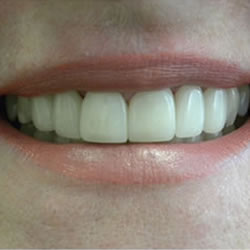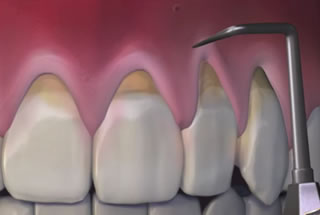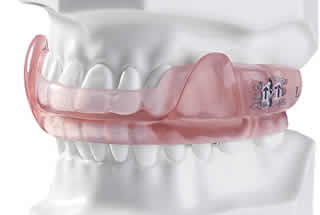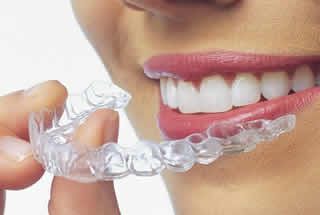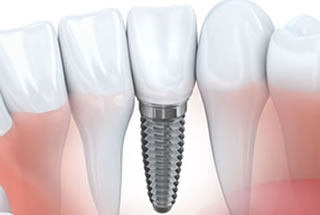
You may have heard of cosmetic dentistry, but are unsure of how that branch of dentistry can help you. There are many reasons to visit a cosmetic dentist! Just about anyone who is embarrassed or unhappy about their smile can find options for improvement through a cosmetic dentist. A wide variety of procedures and treatments are available for a long list of things that you may dislike about your smile.
Restored smile
Cosmetic dentists can restore the appearance and function of your smile. Gaps, crooked teeth, chips, cracks, discoloration and more can be repaired to give you a flawless new look and renewed self-confidence.
Youthful appearance
The older you get, the greater your chances are of problems like lost or yellowed teeth. Gaps in your smile make you look older, and can even change your face shape as it sinks in around the area of tooth loss. Cosmetic procedures can restore your youth through dental procedures.
Whiter teeth
Dull, yellow, stained teeth from years of consuming dark foods or from tobacco use can make your smile unsightly. There’s no need to hide your smile, because professional teeth whitening is available through cosmetic dentists. It can dramatically improve your appearance in only an hour’s time.
Fresh breath
Various dental issues can contribute to stinky mouth odor. Cosmetic dentistry helps take care of oral health problems to give you a better chance at fresh breath.
Healthier gums
Irritated, swollen, or bleeding gums are both painful and unsightly. Poor dental hygiene or even brushing with excessive pressure can promote gum problems. Cosmetic dentists can diagnose gum issues and help restore them to a healthier condition.
Do not wait any longer. Book your appointment now and achieve the smile you have always wanted. Dr. Cruz is accepting new patients from Toronto and the surrounding area.

Everyone hopes to look younger and more attractive, and one way to achieve that youthful glow is to have a beautiful smile. Teeth free of stains, chips, misalignment, cracks and other problems are more likely to help you feel good about yourself and make a better impression on others. One way to achieve this goal is to see a cosmetic dentist for a smile makeover.
Dentists have been helping patients improve the appearance of their smiles for many years, but advances in techniques and materials allow smile makeovers to be much more advantageous today. Silver fillings have been replaced with tooth-colored composite resin, dental implants securely replace missing teeth, teeth whitening methods produce dramatic results, and computer imaging can provide great predictions for the outcomes of various cosmetic dental procedures.
There are many options for a smile makeover depending on what you need:
- Discolored or stained teeth benefit from professional whitening treatment. Yellowed teeth can improve numerous shades of white to give you a whole new look.
- Chips in your teeth can be filled with tooth-colored composite resin in a procedure called bonding. You can choose a shade closely matching your tooth, so that once it is smoothed and polished you can’t even tell it was done.
- Uneven teeth that are slightly longer or shorter than their neighbors can be shaped in a more appealing way using recontouring techniques.
- Gaps between teeth can be closed using composite material, or large spaces can be hidden with dental veneers. In fact, porcelain veneers can cover all sorts of flaws that you don’t want others to see in your smile.
- Cavities or cracked teeth can be filled with tooth-colored material instead of traditional amalgam, making them invisible in the mouth.
- Broken teeth that are unsightly or weak can be covered with a durable and attractive crown.
Crooked teeth can be moved with orthodontic treatment, employing the latest method of Invisalign. These clear plastic aligners transform your smile without the noticeable metal braces that impact your diet and dental hygiene.
Do not wait any longer. Book your appointment now and achieve the smile you have always wanted. Dr. Cruz is accepting new patients from Toronto and the surrounding area.

Invisalign is a revolutionary orthodontic treatment that has gained immense popularity over the years.
Unlike traditional braces, Invisalign uses clear plastic aligners to gently shift teeth into the desired position. This treatment option has become increasingly popular due to its effectiveness in correcting misaligned teeth and its discreet appearance.
Brief Overview of Invisalign and Its Popularity
Invisalign was first introduced in 2000 and has since become a popular alternative to traditional braces, especially among adults who may be self-conscious about their appearance with metal brackets and wires. The aligners are custom-made to fit each patient’s mouth, making them comfortable to wear and easy to remove when needed.
In recent years, Invisalign has gained even more popularity due to advancements in technology that have made the treatment process more efficient. The use of 3D imaging technology allows for highly accurate aligner fabrication, resulting in shorter treatment times and better outcomes.
Importance of Oral Health
Maintaining good oral health is crucial for overall wellness. Poor oral hygiene can lead to a host of issues such as tooth decay, gum disease, bad breath, and even systemic health problems like heart disease or diabetes. Misaligned teeth can also contribute to dental problems by making it difficult to properly clean between teeth or causing bite issues that put undue stress on certain teeth or areas of the jaw.
By straightening teeth with Invisalign, patients can improve their overall oral health by reducing the risk of these issues occurring. In addition, straighter teeth also improve the aesthetics of one’s smile which often leads to increased self-confidence which can boost mental wellbeing as well.
Overall, there are many benefits associated with choosing Invisalign as an orthodontic treatment option beyond just the cosmetic benefits. By investing in oral health with Invisalign, patients can achieve a healthy, confident smile that lasts a lifetime.
What is Invisalign?
Invisalign is a popular orthodontic treatment that straightens teeth using clear, plastic aligners. These aligners are custom-made for each patient using 3D imaging technology. The aligners gradually shift the teeth into their proper position over a period of months or years, depending on the severity of the misalignment.
Invisalign Treatment
Invisalign is an alternative to traditional braces, which use metal brackets and wires to move teeth into place. Invisalign uses a series of clear plastic trays, called aligners, to gently guide teeth into their correct positions. These trays are custom-made for each patient based on impressions taken of their teeth.
Each set of aligners is worn for about two weeks before being replaced by the next set in the series. The Invisalign treatment process begins with a consultation with an orthodontist or dentist who has been trained in Invisalign technology.
During this initial visit, the doctor will evaluate your oral health and discuss your goals for treatment. If Invisalign is determined to be a good option for you, 3D images will be taken of your mouth and used to create custom aligners that fit snugly over your teeth.
Comparison with traditional braces
Compared to traditional braces, Invisalign has several advantages. One major advantage is its appearance; because the aligners are clear and virtually invisible when worn, they are much less noticeable than metal braces.
Another advantage is that the trays can be removed easily for eating and brushing/flossing one’s teeth. Unlike traditional braces which require regular adjustments by an orthodontist or dentist throughout treatment duration (usually every 4-6 weeks), patients using Invisalign typically only require occasional check-ins with their provider during treatment duration (usually every 8-12 weeks).
This is because the aligners are designed to be changed out by the patient at home every two weeks. Invisalign treatment is typically more comfortable than traditional braces as there are no metal brackets or wires that could cause irritation.
However, like with other orthodontic treatments, patients using Invisalign may experience mild discomfort when switching to a new set of aligners, but this usually subsides within a few days. Overall, Invisalign is an advanced orthodontic treatment that offers a comfortable and discreet solution for correcting dental misalignment issues.
How does Invisalign work?
Invisalign aligners work by applying a gentle and consistent force on the teeth, gradually moving them into the desired position. Unlike traditional braces that use metal brackets and wires, Invisalign relies on custom-made clear plastic aligners that fit snugly over the teeth.
The process and steps involved
The first step in getting Invisalign treatment is to consult with an orthodontist or a dentist who is trained in this type of treatment. After determining that Invisalign is a suitable option for you based on your oral health needs and goals, your dental provider will take impressions of your teeth using 3D imaging technology. The impressions will be used to create a virtual 3D representation of your teeth, which will be used to design a customized treatment plan.
Once your aligners are ready, you will wear them for at least 22 hours per day, only removing them for eating, brushing, and flossing. Every two weeks or so, you will switch to a new set of aligners that are slightly different from the previous ones in order to continue progressing towards your desired tooth alignment.
Use of 3D imaging technology
One of the key advantages of Invisalign is its use of advanced 3D imaging technology. This allows dentists and orthodontists to create highly accurate digital models of patients’ teeth and simulate how they will move during treatment. With this technology, dental providers can precisely plan each step in the process and monitor progress along the way.
The use of 3D imaging also means that patients can see what their final results will look like before they even begin treatment. This provides both patients and dental providers with additional confidence as they work towards achieving their goals for better oral health with straighter teeth thanks to Invisalign’s advanced approach to teeth alignment.
Straightening Teeth
One of the most significant benefits of Invisalign for oral health is its ability to straighten teeth. Crooked or misaligned teeth can cause several dental problems, including tooth decay, gum disease, and difficulty cleaning.
Invisalign aligners gently shift the teeth into proper alignment, improving their appearance and function. Straighter teeth also make it easier to maintain proper oral hygiene habits like brushing and flossing.
Improved Bite Alignment
In addition to straightening teeth, Invisalign aligners can also improve bite alignment. Misaligned bites can cause several dental problems such as jaw pain, headaches, and tooth wear, among others. Invisalign aligners work by applying gentle pressure on specific areas of the mouth to improve bite alignment gradually.
Reduced Risk of Tooth Decay and Gum Disease
The proper alignment of teeth and bite reduces the risk of tooth decay and gum disease by making it easier to clean all parts of the mouth adequately. Bacteria thrive in hard-to-reach places that crooked or misaligned teeth create; however, with properly aligned teeth using Invisalign treatment, brushing and flossing become more effective.
Easier to Clean Teeth
Invisalign aligners are removable trays that allow you to remove them when eating or brushing your teeth. In contrast with traditional braces that have brackets attached with wires running through them which makes it difficult for food particles not being trapped between them since they cannot be removed easily for cleaning.
Better Overall Oral Hygiene
Straightening teeth with Invisalign improves overall oral hygiene as it promotes good dental habits such as regular brushing and flossing. Maintaining good oral hygiene helps prevent common dental problems like cavities or gum disease in the long run.
Comfortable Treatment
Unlike traditional braces, Invisalign aligners are made of smooth plastic that fits snugly over the teeth. They have no metal brackets or wires that poke or irritate the mouth and they are more comfortable to wear. Patients can continue their daily life without experiencing discomfort.
Convenient Lifestyle
Invisalign aligners are removable, so patients can take them out when eating, drinking, brushing or flossing; this is an advantage over traditional braces which require dietary restrictions and make it difficult for patients to clean their teeth properly. With Invisalign, there are no dietary restrictions or limitations, and oral hygiene is more accessible to maintain.
Cost considerations
The cost of Invisalign treatment varies depending on several factors including the length and complexity of treatment needed as well as the geographic location of the provider. On average, patients can expect to pay between $3,000 and $8,000 for their entire course of treatment. It’s important to note that many dental insurance plans do not cover orthodontic treatments like Invisalign.
However, some providers offer financing options or payment plans to help make the cost more manageable. It’s also worth considering that while Invisalign may initially seem more expensive than traditional braces, it often requires fewer office visits and less time off work/school since there are no adjustments needed every few weeks.
The importance of compliance with wearing aligners
The success of Invisalign depends heavily on patient compliance with wearing the aligners as prescribed by their provider. This means wearing them at least 22 hours a day, removing them only to eat, drink (anything other than water), brush, and floss.
Inconsistent or improper wear of the aligners can result in slower progress or even relapse of the teeth back to their original position. Providers will often monitor patient compliance with regular check-ins and may adjust treatment protocols if necessary.
It’s important for patients to understand the commitment involved in Invisalign treatment and be willing to adhere to the prescribed regimen. While it may require some adjustments and discipline, the benefits of improved oral health and a confident smile are well worth it in the end.
The benefits and advantages offered by Invisalign for oral health
Invisalign is a highly effective treatment option for those seeking straighter teeth and better oral health. Invisalign offers significant benefits over traditional braces, including improved aesthetics, increased comfort, and greater convenience.
The use of 3D imaging technology allows for a more accurate fit and better results. Additionally, the smooth plastic aligners make it easier to maintain good oral hygiene, reducing the risk of tooth decay and gum disease.
Consider Invisalign for straighter teeth and better oral health
If you are considering orthodontic treatment to improve your smile or overall oral health, Invisalign is a great option to explore. It is important to consult with an experienced orthodontist who can evaluate your individual needs and determine if Invisalign is right for you.
With proper compliance in wearing the aligners for at least 22 hours per day, you can achieve a beautifully straightened smile in as little as 6-18 months. Don’t let concerns about aesthetics or discomfort hold you back from achieving optimal oral health – schedule an appointment today to learn more about how Invisalign can transform your smile!
Do you live in Toronto or the surrounding area? Our team is ready to help you achieve your smile goals. Schedule your appointment today.
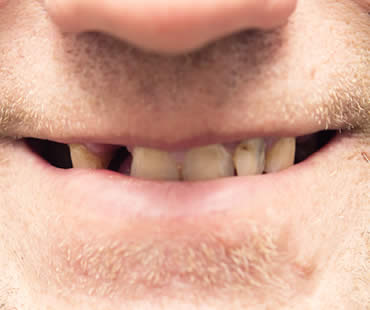
The Importance of Oral Health for Middle Aged Folks
As we age, we begin to experience the effects of time on our bodies. One area that often gets overlooked is oral health.
Taking care of our teeth and gums becomes more important than ever as we hit middle age. Poor oral hygiene can lead to a range of issues, from tooth decay and gum disease to bad breath and even oral cancer.
One reason why oral health is so critical for middle-aged folks is that our bodies become less efficient at repairing themselves. This means that damage done to our teeth and gums can have long-lasting effects, making it essential to take preventive measures wherever possible.
A Brief Overview of Common Oral Health Concerns
Before diving into specific oral health concerns for middle-aged folks, it’s helpful to have a general understanding of what these issues are. Some common concerns include gum disease, tooth decay, bruxism (teeth grinding), dry mouth (xerostomia), bad breath (halitosis), and oral cancer. Gum disease is an inflammation of the gums that can cause tooth loss if left untreated.
Tooth decay occurs when bacteria breaks down enamel and dentin in our teeth, leading to cavities. Bruxism involves grinding or clenching your teeth while you sleep or during the day, which can cause headaches, jaw pain, and even chipped or cracked teeth.
Dry mouth occurs when there’s a lack of saliva production in our mouths due to certain medications or medical conditions. This can lead to bad breath and an increased risk for tooth decay.
Oral cancer can occur in any part of the mouth or throat and requires early detection for successful treatment. Now that we have a general understanding of these concerns let’s dive deeper into what they mean for middle-aged folks specifically.
Gum Disease: The Silent Oral Health Menace
Gum disease, also known as periodontitis, is a serious oral health issue that often goes undetected until it has caused significant damage. The condition is caused by an excess buildup of plaque and bacteria on the teeth and gums. As the bacteria multiply, they cause inflammation and bleeding of the gums, which can lead to tooth decay and even tooth loss if left untreated.
Causes and Symptoms
The primary cause of gum disease is poor oral hygiene habits such as infrequent brushing or flossing. Other factors that can contribute to gum disease include smoking, hormonal changes, diabetes, genetics, and certain medications. Symptoms of gum disease include bleeding gums while brushing or flossing, persistent bad breath or bad taste in the mouth, receding gums that make teeth appear longer than normal, loose teeth or shifting teeth that don’t fit together when biting down.
Prevention and Treatment Options
Preventing gum disease requires consistent oral hygiene practices such as brushing at least twice a day for two minutes each time, flossing daily before bedtime to remove any food particles lodged between teeth. Using an antimicrobial mouthwash will help kill germs in hard-to-reach places.
Getting regular dental check-ups every six months is also important because dentists can detect early signs of gum disease before it becomes more severe. Treatment options for gum disease depend on how advanced the condition has become but can range from deep cleaning procedures like scaling and root planing to surgical intervention in severe cases where bone loss has occurred.
Advanced cases may require periodontal surgery to restore tissue damage done by the bacteria. After treatment patients are given instructions on how best to maintain good oral hygiene habits so that they do not fall victim to this silent menace again in their middle age years especially since aging itself increases our susceptibility to gum disease.
Tooth Decay:
Causes and Symptoms:
One of the most common oral health concerns for middle-aged folks is tooth decay. Tooth decay occurs when the enamel on your teeth is weakened by acid, causing cavities or even tooth loss.
Poor dental hygiene and a diet high in sugar and carbohydrates are two major causes of tooth decay. Additionally, dry mouth or a decrease in saliva production can lead to tooth decay as saliva helps to neutralize acids in the mouth.
Symptoms of tooth decay include sensitivity to hot and cold temperatures, pain when biting or chewing, and visible holes or pits in the teeth. If you experience any of these symptoms, it’s important to see a dentist right away to prevent further damage.
Prevention and Treatment Options:
The best way to prevent tooth decay is through proper dental hygiene practices such as brushing your teeth twice a day, flossing daily, using fluoride mouthwash regularly, and visiting your dentist for routine cleanings and check-ups. In terms of treatment options, early-stage tooth decay can often be treated with fluoride treatments or fillings. However, if the decay has progressed too far, more extensive procedures may be necessary such as root canals or even extraction.
It’s important to address any signs of tooth decay early on as it can lead to more severe oral health problems down the line. By maintaining good dental hygiene habits and being proactive about seeing your dentist regularly, you can prevent tooth decay from becoming a major issue.
Teeth Grinding (Bruxism)
The Causes and Symptoms of Bruxism
Bruxism is the involuntary grinding, clenching or rubbing of teeth. It can happen while you’re awake or asleep, but most people who suffer from bruxism do so at night.
The exact cause of bruxism is not known, but it has been linked to stress, anxiety, sleep disorders, and certain medications. The symptoms of bruxism include jaw pain or stiffness, headaches, earaches, and worn or cracked teeth.
Prevention of Bruxism
There are several ways to prevent bruxism. Reducing stress through relaxation techniques such as yoga and meditation can help alleviate the condition.
Avoiding stimulating substances such as caffeine and alcohol before bedtime can also help reduce the likelihood of bruxism occurring at night. Wearing a mouthguard while sleeping is another effective prevention method.
Treatment Options for Bruxism
If you suspect that you suffer from bruxism, it’s important to consult with your dentist who can diagnose the condition and recommend treatment options. Treatment may involve a combination of lifestyle changes such as reducing stress levels through therapy or medication, wearing a mouthguard at night to protect your teeth from further damage caused by grinding or clenching during sleep or surgery in severe cases. If you are experiencing any symptoms related to teeth grinding , you should have your oral health evaluated by a dental professional right away in order to avoid further damage to your teeth and jaw area.
The Dangers of Dry Mouth (Xerostomia)
Are you experiencing a persistent feeling of dryness in your mouth? This might be because you are suffering from Xerostomia, or dry mouth. It is a common oral health issue that can lead to major problems if left untreated.
Causes and Symptoms
Xerostomia is caused by a decrease in the production of saliva, which can occur due to a variety of reasons. Some of these causes include certain medications, radiation therapy, dehydration, autoimmune diseases such as Sjogren’s syndrome, and nerve damage.
Symptoms of dry mouth include a constant feeling of thirst, difficulty swallowing food, cracked lips and tongue, bad breath, sore throat and gums that bleed easily. If you experience these symptoms frequently you should see your dentist.
Prevention and Treatment Options
The best way to prevent Xerostomia is to keep yourself hydrated at all times by drinking plenty of water throughout the day. Also consider chewing sugar-free gum or sucking on sugar-free candies as this promotes the production of saliva.
If your Xerostomia persists despite practicing good hygiene habits then it might be time to consult with your dentist about further treatment options such as medication or Botox injections. In some cases certain prescription medications are responsible for causing Xerostomia; if this is the case with you then speak to your doctor about changing medication or adjusting dosage.
It’s worth noting that people who suffer from Xerostomia also tend to have an increased risk for tooth decay and gum disease because there’s not enough saliva present in their mouths to wash away bacteria that cause these issues. So don’t ignore this condition!
Oral Cancer: Causes, Symptoms, Diagnosis, Treatment
Oral cancer is a serious disease that can be life-threatening if not detected and treated early. It is a type of head and neck cancer that affects the mouth, tongue, lips, throat, or gums.
The good news is that it is preventable and can be treated if caught in its early stages. Here are some important facts about oral cancer:
Causes
The exact cause of oral cancer is unknown. However, certain lifestyle choices increase the risk of developing it. Tobacco use (including cigarette smoking and smokeless tobacco), excessive alcohol consumption, and HPV (human papillomavirus) infection are some of the main causes of oral cancer.
Symptoms
The symptoms of oral cancer can be similar to those caused by other conditions such as gum disease or toothache. Some common symptoms include persistent mouth sores or ulcers that do not heal within two weeks; red or white patches in the mouth; swelling or lumps in the gums; persistent sore throat; difficulty swallowing or chewing; hoarseness or change in voice quality; numbness in the mouth or face.
Diagnosis
If you experience any symptoms associated with oral cancer for more than two weeks, you should see your dentist as soon as possible for an examination. Your dentist may perform a biopsy (removal and analysis of tissue) to determine if there are any abnormal cells present.
Treatment
Treatment options for oral cancer depend on several factors such as stage of the disease, location and size of the tumor(s), overall health condition of the patient etc. Common treatments include surgery to remove tumors followed by radiation therapy (or chemotherapy), radiation therapy alone (for smaller tumors) or a combination of these methods. Early detection greatly improves the chances of successful treatment and long-term survival.
Remember, prevention is always better than cure. To reduce your risk of oral cancer, avoid tobacco use, limit alcohol consumption, and practice good oral hygiene by brushing twice a day, flossing regularly and visiting your dentist for routine check-ups. Bad Breath: The Stinky Elephant in the Room
As we age, there’s one oral health concern that becomes increasingly noticeable: bad breath. Also known as halitosis, this condition can be a major source of embarrassment and social discomfort. But what causes bad breath, and what can you do to prevent it? Causes:
There are many different factors that can contribute to bad breath in middle aged folks. Some common culprits include poor oral hygiene habits (such as infrequent brushing and flossing), gum disease, dry mouth, smoking or tobacco use, certain medications or medical conditions (like diabetes), and even stress. In some cases, bad breath may also be a sign of more serious issues like oral infections or cancer. Prevention Tips:
The good news is that there are several simple steps you can take to prevent or reduce bad breath in middle age. First and foremost, be sure to brush your teeth at least twice a day (preferably after meals) with fluoride toothpaste and floss daily to remove food particles and bacteria from between teeth. You may also want to consider using an antimicrobial mouthwash to kill germs in your mouth.
In addition to good oral hygiene practices, there are some lifestyle changes you can make to help prevent bad breath. For example, if you smoke or use tobacco products, quitting will not only benefit your overall health but also improve the freshness of your breath.
Drinking plenty of water throughout the day can also help keep your mouth moist and flush out odor-causing bacteria. Another helpful tip is to watch what you eat – certain foods like garlic, onions, coffee or alcohol tend to leave a strong odor in the mouth long after they’ve been consumed.
If possible try cutting back on these types of foods or brushing after eating them. Make sure you see your dentist regularly for check-ups and cleanings.
They can catch any early signs of gum disease or decay and provide treatment to prevent further damage. By taking steps to maintain good oral health, you can keep bad breath at bay and enjoy fresh, healthy breath for years to come!
Maintaining good oral health is crucial for middle-aged people.
Gum disease, tooth decay, and teeth grinding are all common conditions that can cause painful and costly problems if left untreated.
Dry mouth and bad breath can also impact a person’s quality of life. Oral cancer is a serious concern that can be prevented with early detection.
The key takeaways from this article include the importance of regular dental check-ups and cleanings, daily brushing and flossing, a healthy diet low in sugar, and avoiding tobacco products. It’s also essential to recognize the signs and symptoms of these conditions so that they can be treated promptly.
Final thoughts on the importance of maintaining oral health in middle age
As we age, our bodies go through changes that affect our oral health. This means that taking care of our teeth and gums becomes even more critical as we get older.
Maintaining good oral health not only prevents painful dental problems but also has broader benefits for overall health. Studies have shown that poor dental hygiene is linked to heart disease, stroke, diabetes, and other chronic conditions.
By prioritizing our oral health in middle age, we can set ourselves up for a healthier future. With regular check-ups with a dentist or hygienist and by practicing good oral hygiene at home every day, we can maintain strong teeth and healthy gums well into our golden years.
Take the first step towards optimal oral hygiene. Reserve your dental appointment at our Toronto dental office now and experience personalized care.

Why Snacking Right Matters for Your Teeth
Oral health is essential not just for maintaining a beautiful smile but also for overall health. Diet plays a significant role in promoting healthy teeth and gums.
From the time we are children, we are taught about brushing and flossing our teeth to keep them healthy. While these habits help keep our teeth clean and free from food debris, the food we eat has a much bigger impact on our oral health than we realize.
The Role of Diet in Promoting Healthy Teeth and Gums
What you eat affects more than just your waistline; it can have a significant impact on the health of your teeth and gums. A balanced diet that includes nutrients such as calcium, vitamin D, phosphorus, and fluoride helps build strong teeth that resist decay.
Foods that are high in sugar or acidic content can erode tooth enamel over time if consumed frequently. Acidic foods gradually break down tooth enamel leading to cavities or sensitivity issues.
Good oral hygiene practices combined with healthy eating habits are necessary for maintaining optimal oral health throughout life. In the next section, we will discuss snacks to avoid when it comes to maintaining good oral health.
Snacks to Avoid
While snacking provides a quick and easy way to satisfy hunger pangs, not all snacks are created equal. Some snacks can harm your teeth by promoting the growth of harmful bacteria or eroding tooth enamel. Here are some types of snacks you should avoid:
Sugary and Acidic Snacks That Can Erode Tooth Enamel
Sugary and acidic foods and drinks can cause significant damage to your teeth over time if consumed in excess. When you eat sugary foods, the bacteria in your mouth convert the sugar into acid, which erodes the hard outer layer of your tooth enamel. Acidic foods also contribute to enamel erosion by softening the protective layer that covers your teeth.
To minimize damage from sugary and acidic snacks, it’s best to consume them in moderation or avoid them altogether. Common examples of sugary and acidic snacks include candy, soda, sports drinks, fruit juice, pickles, tomatoes, citrus fruits such as oranges and lemons.
Sticky Snacks That Can Get Stuck In Between Teeth
Another type of snack that can be harmful to your teeth is sticky food. Sticky food has a tendency to cling onto tooth surfaces for extended periods, promoting bacterial growth that causes decay over time.
Candy bars with caramel or nougat centers are common culprits for getting stuck between teeth. Similarly dried fruits like raisins can get stuck between teeth making it challenging for saliva to wash away food particles from these areas creating a breeding ground for bacteria.
To minimize harm from sticky snacks try opting for crunchy alternatives like apples or carrots instead of candies or dried fruits. Avoiding these types of snack will go a long way toward maintaining healthy oral hygiene as well as reducing the risk of cavities and tooth decay.
Great snacks for your teeth
A healthy diet plays a significant role in maintaining good oral health. Choosing the right snacks not only helps to keep your body healthy, but also promotes healthy teeth and gums. Here are some great snack options that can improve your oral health.
Crunchy fruits and vegetables
Crunchy fruits and vegetables such as apples, carrots, celery, and cucumbers are great choices for snacking. These foods are high in fiber which helps to scrub away plaque from teeth while stimulating saliva production. Saliva neutralizes harmful acids produced by bacteria in the mouth that can cause tooth decay.
Apples are particularly beneficial because they contain malic acid which aids in cleaning teeth and removing surface stains. Carrots have abrasive qualities that help to remove plaque from teeth while celery is rich in vitamins A and C that promote gum health.
Dairy products
Dairy products like cheese, yogurt, and milk are known to be rich sources of calcium which is essential for building strong bones including teeth. They also contain casein which helps to prevent tooth decay by neutralizing acid produced by oral bacteria.
Cheese is especially beneficial since it contains phosphate which helps to balance the pH level of the mouth preventing dental erosion. Yogurt contains probiotics which fight against bad bacteria that can cause gum disease.
Nuts and seeds
Nuts such as almonds, cashews, and seeds like sunflower or pumpkin seeds provide an excellent source of protein with low sugar content making them ideal for snacking. They also contain essential minerals like phosphorus, magnesium that help strengthen tooth enamel. Almonds have abrasive texture that provides a scrubbing action on teeth surfaces removing plaque buildup while cashews stimulate saliva production aiding in washing away food particles trapped between teeth surfaces.
Sugar-free gum
Sugar-free chewing gum has been shown to help prevent tooth decay by increasing saliva flow which neutralizes acid in the mouth and washes away food particles that can contribute to plaque buildup. Look for gum with xylitol, a natural sweetener that has been proven to have positive oral health benefits. Chewing sugar-free gum after meals also helps to freshen breath, making it a great option if you don’t have immediate access to a toothbrush.
Incorporating these healthy snacks into your diet not only promotes better oral health but also provides many other benefits for your overall well-being. Remember, choosing whole foods over processed snacks is always the best choice for maintaining optimal health.
Tips for Snacking Smartly
Snacking is an essential part of our daily routine, but it can have a detrimental effect on our teeth if we don’t choose the right snacks. Here are some tips to help you make smart snacking choices that promote good oral health.
Limit Snacking Frequency to Reduce Exposure to Acids and Sugars
Frequent snacking throughout the day exposes your teeth to acids and sugars, which can lead to tooth decay and other oral health problems. Instead of snacking all day long, try limiting your snacking frequency and opt for healthier snacks like fruits, vegetables, or nuts.
Rinse Mouth with Water After Snacking if Brushing Is Not Possible
If brushing is not possible after you snack, rinsing your mouth with water can help wash away food particles and neutralize any acid produced by bacteria in your mouth. This helps reduce the risk of tooth decay and gum disease.
Choose Whole Foods Over Processed Snacks
Processed snacks often contain high amounts of sugar and unhealthy fats that can harm your teeth and overall health. Instead of reaching for packaged snacks, choose whole foods like fresh fruits and vegetables or low-fat dairy products like cheese or yogurt. These types of foods are low in sugar, rich in nutrients like calcium that promote healthy teeth and gums.
By following these simple tips for smart snacking choices, you can maintain good oral health while still enjoying delicious snacks throughout the day. Remember always to consult a dentist if you have any oral concerns or questions about dietary habits that may affect your dental hygiene regimen.
Choosing healthy snacks for healthier teeth
Choosing healthy snacks is essential for maintaining excellent oral health. Snacks high in sugar, acid, and stickiness promote tooth decay and gum disease. On the other hand, snacks rich in fiber, calcium, protein, and water content strengthen the tooth enamel and promote saliva production.
Limiting snacking frequency
It’s essential to limit snacking frequency to reduce exposure to acids and sugars that cause dental problems. Frequent snacking creates an acid attack on the teeth by reducing saliva production. The less time it takes between meals and snacks increases the likelihood of developing cavities.
Rinsing mouth with water after snacking
When brushing your teeth is not possible after a snack or meal, rinsing your mouth with water can help remove food particles from the mouth. This action also helps neutralize acidic content in the mouth before brushing later.
Choosing whole foods over processed snacks
Choosing whole foods over processed snacks is beneficial for good oral health. Processed foods contain high levels of sugar which can be harmful to your dental hygiene in many ways.
A diet that includes healthy snack options like fruits, nuts, vegetables as well as dairy products such as cheese and yogurt will provide you with all the necessary nutrients required for good oral health. Practicing proper oral hygiene measures like brushing twice daily with fluoride toothpaste along with a balanced diet can help keep your teeth strong and healthy.
Ready to transform your smile? Schedule your appointment today at our Toronto dental office.

Importance of Dental Health During Pregnancy
Good oral hygiene plays a crucial role in maintaining overall health and well-being. During pregnancy, hormonal changes in the body can lead to an increased risk of several dental problems such as gum disease, tooth decay, and tooth erosion. In addition to these issues, poor dental health during pregnancy has been linked to adverse pregnancy outcomes such as premature birth and low birth weight.
Brief Overview of Common Dental Concerns During Pregnancy
There are several unique dental concerns that pregnant women may face:
- Gingivitis: hormonal changes in the body cause an increase in blood flow to gums making them more sensitive and prone to inflammation which leads to gingivitis
- Tooth decay: morning sickness causes acid reflux which leads to enamel erosion on teeth
- Pregnancy tumors: overgrowth or swellings occur more often on gum tissue due to hormonal changes
- Dry mouth: pregnant women may experience dry mouth due to hormonal fluctuations which can lead them vulnerable for cavities and gum disease
- Cavities: pregnant women may develop cavities if they consume more sugary foods or experience morning sickness
Although these dental concerns can be concerning, they can be prevented with proper oral hygiene and regular dental check-ups. Next, we will delve into the most common dental problems experienced by pregnant women: hormonal changes and gum disease.
Hormonal Changes and Gum Disease
Pregnancy is a unique phase of life when a woman’s body undergoes many hormonal changes. These changes can increase the likelihood of developing gum disease, also known as periodontal disease.
The hormone progesterone, which increases during pregnancy, causes an exaggerated response to plaque and bacteria in the mouth. This can lead to red, swollen and bleeding gums.
Symptoms and signs of gum disease in pregnant women
Early signs of gum disease include swollen gums that bleed easily when brushing or flossing. As the disease progresses, pockets form between the teeth and gums and may cause bad breath or a bad taste in the mouth. In advanced stages, teeth may become loose or fall out.
Prevention and treatment options for gum disease during pregnancy
Prevention is always better than cure, so it’s important to maintain good oral hygiene practices during pregnancy such as brushing twice daily with fluoride toothpaste and flossing regularly. Regular dental check-ups with a dentist are also crucial as they can identify any potential issues early on.
Treatment for gum disease during pregnancy may include deep cleaning procedures such as scaling and root planing (which removes plaque build-up below the gum line) or more extensive treatment if needed after delivery. If you suspect you have gum disease while pregnant, you should contact your dentist right away to schedule an appointment.
Morning Sickness and Tooth Erosion
Morning sickness is a common symptom experienced by many pregnant women. This condition is characterized by nausea and vomiting, particularly during the first trimester of pregnancy. Unfortunately, the acidic vomit produced during morning sickness can have a negative impact on dental health.
The acid present in vomit can cause tooth erosion, which is the wearing away of the enamel on teeth. Tooth erosion can cause sensitivity and pain while eating or drinking.
Tips for Preventing Tooth Erosion During Pregnancy
Preventing tooth erosion during pregnancy starts with good dental hygiene practices. Pregnant women should brush their teeth twice daily for at least two minutes with fluoride toothpaste. They should also floss daily to remove food particles that may be stuck between teeth and gums.
Additionally, pregnant women should rinse their mouth with water after vomiting to help neutralize any stomach acid left in the mouth. Pregnant women can also take steps to reduce morning sickness symptoms, which will ultimately help prevent tooth erosion.
Eating small meals throughout the day instead of large meals can reduce nausea and vomiting episodes. Drinking plenty of fluids, such as water or herbal tea, can also help reduce morning sickness symptoms.
Treatment Options for Tooth Erosion in Pregnant Women
If tooth erosion does occur during pregnancy, treatment options will depend on the severity of the condition. If caught early enough, enamel remineralization treatments may be used to restore some of the lost enamel on teeth.
In more severe cases, restorative dentistry procedures such as fillings or crowns may be necessary to repair damaged teeth. However, it’s important for pregnant women to consult with their dentist regarding any dental procedures they may need as some treatments are not recommended during pregnancy.
Pregnancy Tumors
Definition and Explanation of Pregnancy Tumors
Pregnancy tumors, also known as pyogenic granulomas, are non-cancerous growths that can develop on the gums during pregnancy. These growths are typically localized, meaning they only affect one area of the gums, and can range in size from a few millimeters to over a centimeter. They are usually painless, although some women may experience discomfort or bleeding when brushing their teeth.
Symptoms, Causes, and Risk Factors Associated with Pregnancy Tumors
The exact cause of pregnancy tumors is unknown. However, hormonal changes during pregnancy are believed to play a role in their development.
Specifically, an increase in estrogen and progesterone levels can cause an overgrowth of blood vessels in the gums. This overgrowth can then lead to the formation of pregnancy tumors.
While pregnancy tumors can develop in any woman who is pregnant, some women may be at a higher risk than others. For example, women who have poor dental hygiene or pre-existing gum disease may be more likely to develop these growths.
The symptoms of pregnancy tumors include red or purple bumps on the gums that bleed easily when touched or brushed. Some women may also experience pain or discomfort in the affected area.
Treatment Options for Pregnancy Tumors
In most cases, pregnancy tumors do not require treatment and will go away on their own after delivery. However, some women may choose to have them removed if they cause discomfort or embarrassment. If treatment is necessary, there are several options available.
One common treatment is surgical removal of the tumor under local anesthesia. Laser therapy may also be used to remove the growth while minimizing bleeding and discomfort.
Good oral hygiene practices such as regular brushing and flossing can help prevent the development of pregnancy tumors during pregnancy. Additionally, seeing a dentist for regular checkups and cleanings can help identify and treat any dental concerns before they become more serious issues.
Medications During Pregnancy
The Impact of Medications on Dental Health
Pregnant women are often prescribed medications to manage various health issues, but some medications can affect dental health. For example, certain antibiotics like tetracycline can cause tooth discoloration in developing fetuses.
Additionally, some over-the-counter pain relievers like aspirin and ibuprofen are not recommended during pregnancy because they can increase the risk of bleeding. Therefore, pregnant women should always inform their dentists and doctors about any medications they are taking to ensure that they receive the appropriate dental care.
Safe Medications for Pregnant Women
There are many safe options for pregnant women who need dental treatment. For example, topical fluoride treatments and local anesthesia are generally considered safe during pregnancy.
Antibiotics like penicillin and erythromycin are also generally safe for use during pregnancy. However, it is important to remember that every medication has risks associated with it, so dentists and doctors must weigh the benefits against any potential adverse effects.
Precautions when Taking Medication
While certain medications may be deemed safe during pregnancy, it is always important to take precautions when taking any medication. Pregnant women should always follow their doctors’ instructions carefully and only take medications as prescribed. They should also avoid self-medicating or taking medication without consulting a healthcare provider first.
Furthermore, pregnant women should inform their dentists or doctors if they experience any side effects from their medication or if they have any concerns about their treatment plan. Overall, while there may be some risks associated with taking medication during pregnancy as it affects dental health; seeking professional advice from healthcare providers can help minimize these risks and promote healthy outcomes for both mother and baby.
Nutrition During Pregnancy And Its Effect On Dental Health
Importance of nutrition in maintaining good oral health
A healthy diet is essential for maintaining good oral health during pregnancy. It is important to eat a well-balanced diet that includes a variety of fruits, vegetables, whole grains, lean proteins, and dairy products.
Calcium and vitamin D are particularly important for maintaining strong teeth and bones. Pregnant women should also drink plenty of water to stay hydrated.
Listing out foods that promote good oral health
Foods that promote good oral health include those that are rich in calcium and vitamin D, such as dairy products (milk, cheese, yogurt), leafy greens (kale, spinach), almonds, and salmon. Foods high in vitamin C (citrus fruits, strawberries) can also help strengthen gums and prevent gum disease. Crunchy fruits and vegetables like apples and carrots can help clean teeth naturally.
Foods That Should Be Avoided
During pregnancy it’s best to avoid sugary foods which contribute to tooth decay. Soft drinks should be avoided as they contain high levels of sugar which can harm the teeth already weakened by hormonal changes during pregnancy. Eating between meals or snacking all day leads to increased exposure to acid which is not good for the teeth either.
Eating a balanced diet during pregnancy is essential for overall health including dental hygiene.
Proper nutrition helps ensure the growth of a healthy baby while decreasing risks associated with premature birth or low birth weight. By consuming enough vitamins & minerals from quality food options pregnant women will maintain strong teeth while reducing their risk of gum disease or tooth decay even with hormonal fluctuations during pregnancy.
Are dental issues holding you back? Take control of your oral health by booking an appointment with our experienced team at our Toronto dental office.







 E-Mail Us
E-Mail Us  416-595-5490
416-595-5490